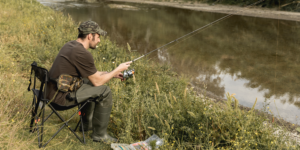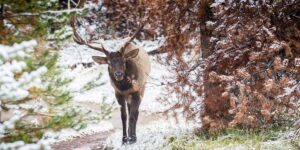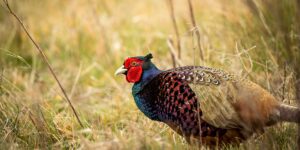What is upland bird hunting and where is the best place to hunt the different species?
Hunting upland birds goes back centuries in not only America, but also Europe. Pheasant and grouse have long been a sought after table fare for Kings and Native Americans. Lewis and Clark even have numerous journal entries discussing upland birds such as grouse on their journey to explore the West.
There are many species of upland birds across the United States that provide upland hunters and gun dogs numerous hunt opportunities throughout the year. But what is an “upland bird” and where can you find and hunt them? Read on.
Looking for Upload Gear? Don’t miss our Upland and Pheasant Hunting Gear List.
Why limit yourself to public land when there are millions of acres of private land to explore.
What is Upland Bird Hunting?
First, it’s important to understand what the term “upland land” means to better understand what upland birds are. “Upland” vegetation, according to the National Park Service, are land areas lying above elevation where flooding generally occurs. Uplands can include grasslands, shrublands, woodlands, rock outcrops, forests, and more.
Game birds referred to as upland birds are non-waterfowl game birds that reside above wetlands, or in the “uplands.” There are many species of upland birds but the most popular are the ringneck pheasant, bobwhite quail, ruffed grouse, and American woodcock. You may have also heard of other upland game birds such as sharp tailed grouse, chukar partridge, Hungarian partridge, greater prairie chickens, lesser prairie chickens, sage grouse, forest grouse such as blue grouse, prairie grouse, and different species of quail such as California, Gambel’s, Mearn’s, and Scaled.
Upland bird hunting is a form of hunting where game birds are pursued in their natural habitat. This can include open fields, woodlands, or other areas where the birds are known to reside. Upland bird hunting is often done with hunting dogs bred and trained to specifically hunt game birds, but can also be hunted without a dog.
Best Habitat to Hunt Upland Birds
Hunting habitats and states vary depending on the upland birds you would like to hunt.
Wild pheasants are found in the midwest and West, and love Conservation Reserve Program (CRP) lands, grasslands, and agriculture fields. Ruffed grouse are a forest bird and can be found ranging from the Eastern side of the U.S., to the Northwoods of Minnesota and Wisconsin, all the way across Western states such as Montana, Utah, and Idaho. Quail prefer CRP and other native grassland and even desert like environments and range from the southern states to the midwest, on to the southwest and west. Woodcock are a migratory bird that prefer areas with damp lands. They can be found in alder trees or other forest environments, and migrate from Canada down through the midwest states such as Michigan, Minnesota, Wisconsin, down to Louisiana.
The other popular upland birds such as sharp tailed grouse, prairie chickens, sage grouse, and Hungarian partridge can be found across western states and prefer grassland habitats or sage brush rolling fields. Chukar partridge prefer hot environments in states such as Idaho, Utah, Nevada, and Oregon. You can find chukar in rocky, steep environments. The mountain birds prefer cheatgrass and sharp rock outcroppings.
Best States for Upland Bird Hunting
Upland birds can be found spread across the United States—different species thrive in different regions. From the pine forests of Maine, to the red clay of Georgia; across the rolling plains of the midwest, and mountain regions of Utah and Idaho, and beyond, upland birds can be found.
The best states for upland hunting depend on what species you would like to pursue. If you’re looking to hunt pheasant or bobwhite quail, set your sights on the plains of Kansas. You can add bonus birds in Kansas as well by hunting greater or lesser prairie chickens.
If you want a long-tailed rooster in the bag, head to the “Pheasant Capital of America,” otherwise known as South Dakota. You can hunt both wild and preserve birds, and add a wild sharptail grouse to the bag if you time it right. Head north to North Dakota if you want not only wild roosters, but also a chance at sharptails and Hungarian partridge.
Head to the southwest and panhandle region of Nebraska for more opportunities for pheasant, or the Nebraska Sandhills for sharptail grouse and greater prairie chickens.
Looking for more of a western bird hunting adventure? You can’t go wrong with Idaho for a multitude of species in varying terrain. Lace up your boots for a steep trek for chukar, or head to the grasslands to hike for an opportunity at Hungarian partridge. If you really want to round out the trip, you may just bag a California quail in the river bottoms in the southern portion of the state.
Importance of Land Access with Upland Bird Hunting
The above list has you wanting to plan a hunt to try your hand at upland hunting…but where can you hunt? Luckily for you, millions of acres of public land are open to hunters across the U.S. These lands are free to hunt and give you ample opportunities to go on a hike with a shotgun.
Land access can also be found on private lands, and often lead to better hunting because of the lack of hunting pressure by other hunters pursuing the same game birds as yourself. Private land hunting can be acquired through permission, or through payment. Wing It takes the hard work out of it for you and saves you from knocking on doors.
The platform works with landowners to give hunters opportunities to “rent” their private lands for hunting. The hunter can locate private land enrolled in the Wing It program and pay a small fee to access the land to hunt. This program opens more lands to hunting, and that means more opportunities at upland birds.
Click on one of the map pins below to learn more about the properties.
Hit the Road
Whether you’re interested in hunting ruffed grouse through Maine’s iconic forests, or pheasants across the CRP lands of the midwest, or chukar up steep, sharp mountains, upland hunting is for you.
Be sure to check state regulations regarding season dates and bag limits. Grab a shotgun, shells, and a bird vest and hit the uplands.
See our full list of top states for Upland Bird Hunting
Upland Bird Hunting Strategies
Upland bird hunting, like all hunting, requires understanding of what habitat birds live in, as well as an understanding of how they move and the best way to bring them to bag. Experienced bird hunters have spent years afield studying their quarry, and the best tactics to hunt them.
You might ask yourself, “do I need a dog?” It’s true that upland hunting is often done with a bird dog, and having a dog definitely ups your odds of success, but the short answer is no, you don’t need a dog. It’s important to understand the cover that birds like to inhabit, and to know when birds are most active. Do you need to hunt mornings, afternoons, or evenings? Studying up on the habits of the bird species you plan to hunt will possibly raise your chances of success.
Going afield with the proper equipment is also vitally important. You want to be successful and put a bird in your game bag without wounding and losing the animal. That means it’s important to choose the right gauge, shell, and shotgun choke to get the job done.
You also need to make sure that you are up for the task of upland bird hunting. Get yourself in shape long before the season starts. You will be walking many miles a day to have a chance at a covey. Practice general hunting techniques such as walking slowly, being quiet, and taking ethical shots at game animals. Always be aware of your surroundings and what is behind your target. Never shoot a bird on the ground. That can put the safety of you, the people around you, and dogs at risk.
The hassle free way to monetize your acreage.
Upland Hunting Gear
You’ve studied, you’ve watched all the videos, and now you’re ready to hit the pheasant field this fall…but not quite yet. Hunting wily roosters is an adventure and requires the right gear to get the job done.
Before you hit your local sportsman’s store, what gear do you need and what can you leave out of your shopping cart? The first and foremost piece of gear you should head to the counter for is your hunting license. You’ll need to complete a hunter education course before you can purchase one, so be sure to plan ahead.
The next most important piece of gear for hunting upland birds is a shotgun. Pheasants are shot on the wing, meaning in the air, so a scattergun is used to get the job done. Shotguns come in a range of shot sizes. Choose the best size that fits you. A heavy 12-gauge may be too much for you and you may need to go to a 20-gauge, etc. Make sure you understand the difference in shotgun shell shot sizes, and which is best for different species.
Next, you’ll need the proper outfit to handle the varying weather. You may find yourself hunting the early season, and you’ll just need brush pants and a light shirt, or you could be chasing roosters in late December and you need warmer gear. Be sure you know the weather before heading afield and dress appropriately. Good boots are important and need to be broken in well before the season. A bird vest hold not only your shells and birds, but also other vital gear such as keys, cell phone, extra layers, and more.
Check out the full Upland Bird Hunting Gear List
Conclusion
Upland bird hunting is an age old pastime that continues to grow in popularity in this day and age. Wild birds can be found across the U.S. and give hunters an exciting opportunity at hunting these fast flying fowl. Utilize the information above to have a fun, successful, and safe day afield chasing birds.
Why limit yourself to public land when there are millions of acres of private land to explore.



